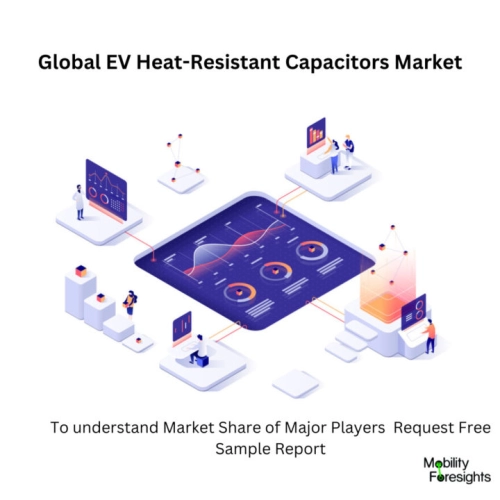
- Get in Touch with Us

Last Updated: Apr 25, 2025 | Study Period: 2024-2030
EV heat-resistant capacitors, as the name implies, are capacitors created especially for use in electric cars (EVs), where they are subjected to high temperatures. These capacitors are made to endure the high temperatures normally present in EV systems, such as those located in the engine compartment or close to power electronics components, and to perform reliably under those conditions.
The electric powertrain, power electronics, and battery systems are only a few of the components of an electric car that produce heat. Standard capacitors, which are not made to withstand such high temperatures, may operate poorly and last less time as a result of this heat.
Consequently, materials and designs used in the construction of EV heat-resistant capacitors allow them to endure and perform well under these demanding circumstances.

The EV Heat-resistant capacitors accounted for $XX Billion in 2023 and is anticipated to reach $XX Billion by 2030, registering a CAGR of XX% from 2024 to 2030.
Murata Manufacturing Co., Ltd. produces a range of heat-resistant capacitors known as the THCR Series. Capacitors, inductors, resistors, and sensors are just a few of the electrical components that Murata offers to customers throughout the world.
The capacitors of the THCR Series are made particularly to endure high temperatures and deliver dependable performance in difficult applications, such electric vehicles (EVs).
Murata's THCR Series capacitors are designed to be highly thermally stable and resistant to temperature extremes by utilizing cutting-edge materials and manufacturing methods. These capacitors are designed to preserve their electrical properties and dependability even in hot settings.
This qualifies them for usage in a variety of automotive applications, including EV powertrains, battery management systems, and on-board charging systems, where heat resistance is essential.
The high-temperature rating of the THCR Series capacitors is one of its primary characteristics. These capacitors are intended to function dependably at temperatures up to a certain threshold, which is often greater than the operating temperature of ordinary capacitors.
The capacitance and voltage ratings of the capacitor in the THCR Series can affect the specific temperature rating. With this high-temperature capabilities, the capacitors can withstand the heat produced in EV applications without sacrificing reliability or performance.
| Sl no | Topic |
| 1 | Market Segmentation |
| 2 | Scope of the report |
| 3 | Abbreviations |
| 4 | Research Methodology |
| 5 | Executive Summary |
| 6 | Introduction |
| 7 | Insights from Industry stakeholders |
| 8 | Cost breakdown of Product by sub-components and average profit margin |
| 9 | Disruptive innovation in the Industry |
| 10 | Technology trends in the Industry |
| 11 | Consumer trends in the industry |
| 12 | Recent Production Milestones |
| 13 | Component Manufacturing in US, EU and China |
| 14 | COVID-19 impact on overall market |
| 15 | COVID-19 impact on Production of components |
| 16 | COVID-19 impact on Point of sale |
| 17 | Market Segmentation, Dynamics and Forecast by Geography, 2024-2030 |
| 18 | Market Segmentation, Dynamics and Forecast by Product Type, 2024-2030 |
| 19 | Market Segmentation, Dynamics and Forecast by Application, 2024-2030 |
| 20 | Market Segmentation, Dynamics and Forecast by End use, 2024-2030 |
| 21 | Product installation rate by OEM, 2023 |
| 22 | Incline/Decline in Average B-2-B selling price in past 5 years |
| 23 | Competition from substitute products |
| 24 | Gross margin and average profitability of suppliers |
| 25 | New product development in past 12 months |
| 26 | M&A in past 12 months |
| 27 | Growth strategy of leading players |
| 28 | Market share of vendors, 2023 |
| 29 | Company Profiles |
| 30 | Unmet needs and opportunity for new suppliers |
| 31 | Conclusion |
| 32 | Appendix |